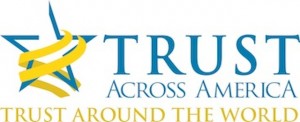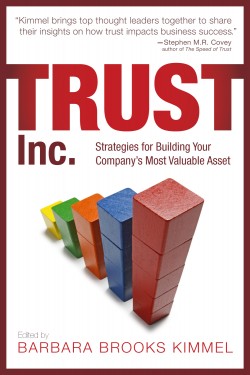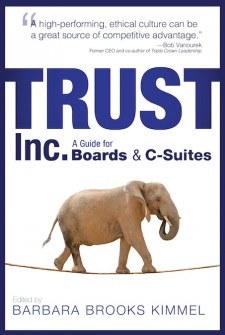Late last year Trust Across America-Trust Around the World published the first in a planned series of award-winning books. The book, TRUST INC. Strategies for Building Your Company’s Most Valuable Asset brings together the wisdom of 32 experts and is divided into six chapters:
- Why Trust Matters- read our blog of July 18 to find out Why Trust Matters
- Trust in Practice- read our blog of July 18 for Trust in Practice from Apple to Africa
- Trustworthy Leadership read our blog of July 19 for Secrets of Trustworthy Leadership
- Building Trustworthy Teams (today’s blog post)
- Restoring Trust
- The Future of Trust
Over a six day period, our blog will extract highlights from these chapters. Each strategy stands alone as an excellent resource in helping leaders understand why trust matters, and provides tools for those who choose to implement trust building programs in their organization. Today we take a closer look at 5 strategies for Building Trustworthy Teams.
William Benner explains how to “Practice Trustworthy Behaviors”
There are many internal and external factors that can affect the ability of individuals and team members to trust one another and accomplish personal goals and team objectives. (These are just a few taken from a longer list.)
- Highly competitive, rapidly changing and uncertain business environment
- Inability and/or unwillingness to address performance issues as a team
- Poor communication skills and inability to listen for understanding
- Lack of clarity about the team’s shared mission and direction
- Lack of confidence in the team leader and/or team members
***********
Mary Gentile describes how to “Build the Trust Muscle: In Our Companies, In our Teams, In Ourselves”
No one publicly debates the necessity for trust in business transactions, to allow for efficient arms-length business transactions and to reduce the cost of regulatory compliance, monitoring and penalties. However, actual behaviors are often slow to change. Too often, when scandals hit or when bubbles burst, we rush to the bully pulpit, proclaiming the necessity to clean up our acts; to place transparency and integrity at the heart of our business dealings; to treat employees and consumers with the respect that comes from honest communication and practices that are consistent with the business mission and values statements.
**********
Jim Kouzes & Barry Posner remind us that “You Can’t Take Trust for Granted”
Every single relationship is built on trust. It’s foundational. It’s fundamental. And foundations and fundamentals need constant attention. Building trust is a process that begins when someone is willing to risk being the first to open up, being the first to show vulnerability, and being the first to let go of control––and then reciprocating these actions. And in the leader-constituent relationship, leaders go first. If you want the high levels of performance that come with trust and collaboration, you have to be the first to demonstrate your trust in others before asking them to trust you.
**********
Hear what Brian Moriarty has to say in “Creating Thriving Organizations- The Bedrock of Trust and Reputation”
Purpose-driven organizations have an important advantage because they are able to tap into the intrinsic motivation of their people. Intrinsic motivation refers to activities or work that people find rewarding in and of itself: for example, a pharmaceutical researcher who is driven by a desire to alleviate suffering caused by a particular disease. When work is intrinsically motivating, performance and creativity thrive. When employees have a voice in the mission of the organization, purpose becomes part of a living conversation with people asking, “What is the unique value that this organization provides for the world?” Companies need employees to be asking this question repeatedly.
**********
And finally, Robert Whipple reminds us that “Reinforcing Candor Builds Trust and Transparency”
A simple three-part model of how leader behaviors can help build higher trust includes three categories of behaviors.
1. Table Stakes
These are the basic building blocks of ethics and integrity that must be present for any level of trust to kindle. The term Table Stakes comes from the phenomenon in poker where individuals must ante up even to play in the game. Traits like honesty, openness, communication, consistency, and ethics simply must be present, or the leader may as well take off his suit and hit the showers.
2. Enabling Actions
These are the components that further help build trust once the Table Stakes are present. There are thousands of items we could name in this category. Here are some examples: following up, advocacy, fairness, admitting mistakes, and many others. The more these elements are present, the greater the ability for the leader to withstand trust withdrawals.
3. The Heart of Trust – Reinforcing Candor
Reinforcing candor is the ability to make people glad they brought up an observation of a leader’s inconsistency. In most organizations, people are punished in some way for bringing forward a leadership problem. Where the highest levels of trust and transparency are present, the leader has the ability to set aside his ego and reinforce those who challenge an action.
************
I hope you have enjoyed this sneak peak into the trust treasures contained in our book. Did I mention that the book has won both a Nautilus Business Book and Eric Hoffer Grand Business Prize Award? Tomorrow I’ll pull some similar gems from Restoring Trust. Check back with us soon.
If this brief look behind the door has been helpful, follow this link to order the book online.
Barbara Brooks Kimmel is the Executive Director of Trust Across America-Trust Around the World whose mission is to help organizations build trust. She is also the editor of the award winning TRUST INC. book series. In 2012 Barbara was named “One of 25 Women Changing the World” by Good Business International.
If you would like to communicate directly with Barbara, drop her a note at Barbara@trustacrossamerica.com
Copyright © 2014, Next Decade, Inc.




Recent Comments